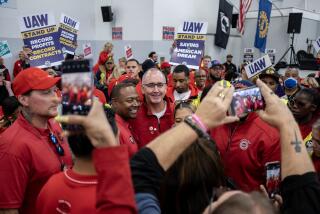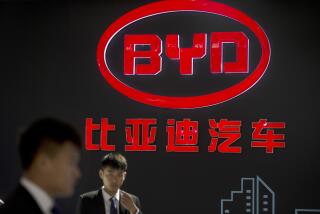Workers Left Out of the ‘Join ‘em’ Strategy
- Share via
An amusingly sarcastic epigram used by the cartoon character Pogo might well be used to summarize an unamusing strategy that the American auto industry has adopted to combat its foreign competition:
“We have met the enemy and they is us.”
The auto industry’s battle plan is based on the non-belligerent notion that “if you can’t beat ‘em, join ‘em.”
That may help increase profits for General Motors, Ford and Chrysler in international competition. But it already has hurt badly American auto workers by drastically reducing the number of jobs in the industry in the United States. And there’s no longer a steadily rising standard of living for those still employed.
Worried by sales downturns, U.S. auto makers began meeting the foreign competition by buying huge stakes in their “enemies.”
GM, Ford and Chrysler also significantly increased their purchase of foreign-made cars, slapping U.S. nameplates on them and then selling the cars in this country.
A third part of the strategy to defeat the foreigners, who seem so hard to beat in direct competition, was to substantially boost the amount of outsourcing.
Outsourcing is a benign-sounding word for the Big Three’s practice of buying parts for American cars from foreign competitors as well as from other U.S. firms. It sounds benign, but it puts more American auto workers out of jobs.
To further their battle plans, U.S. auto makers also are entering into more and more joint ventures. Those are deals in which U.S. auto firms team with foreigners to make cars at jointly owned plants either in or out of this country. Just two of the many examples: Ford and Volkswagen in Brazil, and the GM-Toyota venture in Fremont, Calif.
American workers suffer additional job losses as U.S. companies increase car production in their plants outside the United States. Many vehicles are exported from the American-owned plants in foreign countries for sale here.
Perhaps American auto companies have concluded that with enemies like they now have abroad, who needs friends? Except, that is, for those friendly American consumers.
That corporate view isn’t shared by American auto workers, though. Their ranks continue to dwindle rapidly as their employers form closer and closer alliances with foreign competitors.
There are now only about 527,000 auto workers in the United Auto Workers, compared to 720,000 in the peak membership year of 1979. And U.S. auto workers face more trouble if the industry pursues its peculiar strategy for competing against foreign competitors.
Some experts say another 200,000 auto industry jobs may be lost by 1990 if the hemorrhaging isn’t stopped.
The companies profess great concern for their workers, but there are no signs of a switch in their battle plans to help the battered U.S. auto industry work force.
For instance, they aren’t changing the “buy ‘em” tactic, and are continuing to buy chunks of their foreign foes.
Chrysler Chairman Lee A. Iacocca is at least a bit hypocritical when he furiously denounces those terrible foreign competitors and demands that they voluntarily limit their U.S. sales, or have such sales limited by Congress.
Those verbal attacks are made even though he knows, of course, that Chrysler owns 15% of the giant Japanese auto maker Mitsubishi and buys tens of thousands of Mitsubishi cars from plants in Japan for sale in the United States.
Chrysler also owns 25% of Taiwan’s Yu Loong Motors, 100% of Lamborghini, 15% of Maserati and 50% of the auto parts unit of Samsung, a huge Korean firm.
Likewise, Ford owns 25% of Japan’s Mazda, 10% of Korea’s Kia Motors, 42% of South Africa’s Samcor Motors and 70% of the Taiwanese company Lio Ho which will soon be selling us cars manufactured by Taiwanese workers who earn less in a day than Americans do in an hour.
Or take GM. It owns 38.1% of Japan’s Isuzu, 50% of the auto-manufacturing division of Korea’s Daewoo (which makes the “Pontiac” Le Mans), 60% of the British sports car producer Lotus and 20% of Comau, the Italian company that makes machine tools for U.S. auto plants.
What could be called reflagging is another part of the U.S. companies’ overall battle plan.
In 1979, when U.S. auto employment was at its peak, 6.2% of Chrysler’s car sales in the United States were cars the company imported from the supposed enemy.
The percentage of Chrysler’s reflagged cars has doubled since then, and it is estimated that in less than three years, those imports--largely from its partner, Mitsubishi, will make up 18.9% of Chrysler’s U.S. sales.
Ford, too, has its so-called captive imports. They made up only 3.7% of Ford’s U.S. sales in 1978. As things are going, by 1990, foreign cars reflagged as Fords are expected to rise to almost 14% of Ford’s U.S. sales. That could come largely from sales of “Ford’s” Korean-made Festiva.
The reflagging picture is a little better at GM. Its captive imports are projected to account for only 9.2% of U.S. sales by 1990.
The practice of buying foreign-made parts to build American cars also is increasing as U.S. auto companies press their efforts to beat the foreign competition. It is estimated that about 15% of the parts in U.S. cars are made in other countries, and the University of Michigan’s David E. Cole says the percentage could double by 1990.
Congress so far has, unfortunately, rejected a proposal by the United Auto Workers that would curb outsourcing of parts from abroad. The proposal would require the Big Three auto makers to gradually increase the proportion of American-made parts in their cars labeled Made-in-America to 90%.
Several foreign competitors have opened auto plants in this country, and those plants provide some jobs for U.S. workers. But Americans working in the plants mostly just assemble autos with parts made in Japan.
In contrast, most of the components of the cars assembled at U.S.-owned plants in foreign countries are also made by workers in those countries.
It isn’t fair to call the American auto companies un-American because of the “join ‘em” strategy they are using to combat foreign competition. But it would be dandy for this country if the U.S. firms would concentrate more on increasing American-made autos as the crucial part of their strategy to deal with international competition.
Crossing Guards Back as City Employees
Happily, Los Angeles school crossing guards have been able to buck the trend toward privatization even though more and more entrepreneurs across the nation are taking over work that has been done by government.
The Los Angeles City Council voted last week to let the crossing guards--of whom 90% are women and 60% are minorities--return to their status as city employees.
They were city workers for 45 years until their jobs were taken over by a private firm, All City Management, two years ago.
City workers’ wages have risen 10.5% since then. But the crossing guards, as private sector employees, got no boost in their $6.01-an-hour wage over the same period and lost many fringe benefits provided by the city.
Just before their jobs were privatized, the guards voted overwhelmingly to join Teamsters Union Local 911, which had pleaded in vain with the City Council not to push the workers off the city payroll.
Finally, though, the council voted 8-to-4 to let the guards return as city employees--but only on the condition that their union negotiate a contract costing the city no more than All City Management charged.
Hugo Morris, the Teamsters official who spearheaded the effort to put the crossing guards back on the city payroll, said negotiations will begin immediately, and “we will have no trouble getting an agreement. After all, the city doesn’t have to make a profit out of these crossing guards who protect our children.”
Wouldn’t it be fine if the victory for the crossing guards slowed the privatization trend so ardently pursued by its most famous advocate, President Reagan?






